Redwood: Create and Edit Purchase Orders
Create and update purchase orders for goods and services delivered to an expense destination using a Redwood page.
Here's a list of key features and considerations for creating purchase orders in this release:
New Purchase Order Drawer
Use the Create Purchase Order option on the new Purchase Orders page to open a drawer to select an appropriate document style, procurement business unit, requisitioning business unit, supplier, supplier site, supplier contact, currency, and default ship-to location for creating a purchase order. Based on the information you enter, the application derives the bill-to business unit and sold-to legal entity on the purchase order.

Use the Create Purchase Order Button to Open the New Purchase Order Drawer
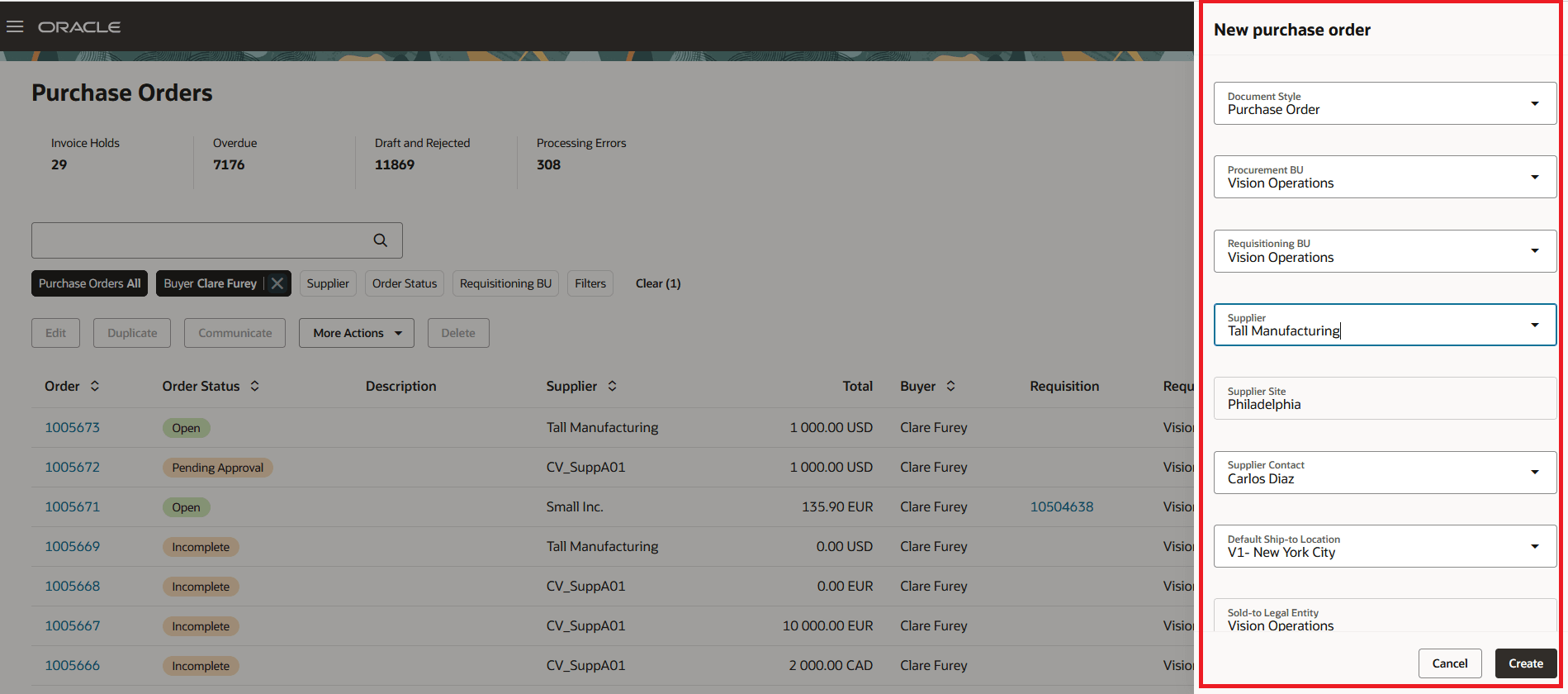
Enter Key Purchase Order Header Attributes in the New Purchase Order Header
Purchase Order Lines
Use the Lines tab to enter details of the goods or services being ordered on the purchase order. You can order predefined items, fixed-price services, or services billed by quantity.
You can search for predefined items using attributes such as item number, item description, manufacturer, manufacturer part number, supplier item, and item's extensible flexfields using the new user search experience. Use the More search options link to filter the search results by the item's primary unit of measure and configure personal search views to display additional attributes in the search results.
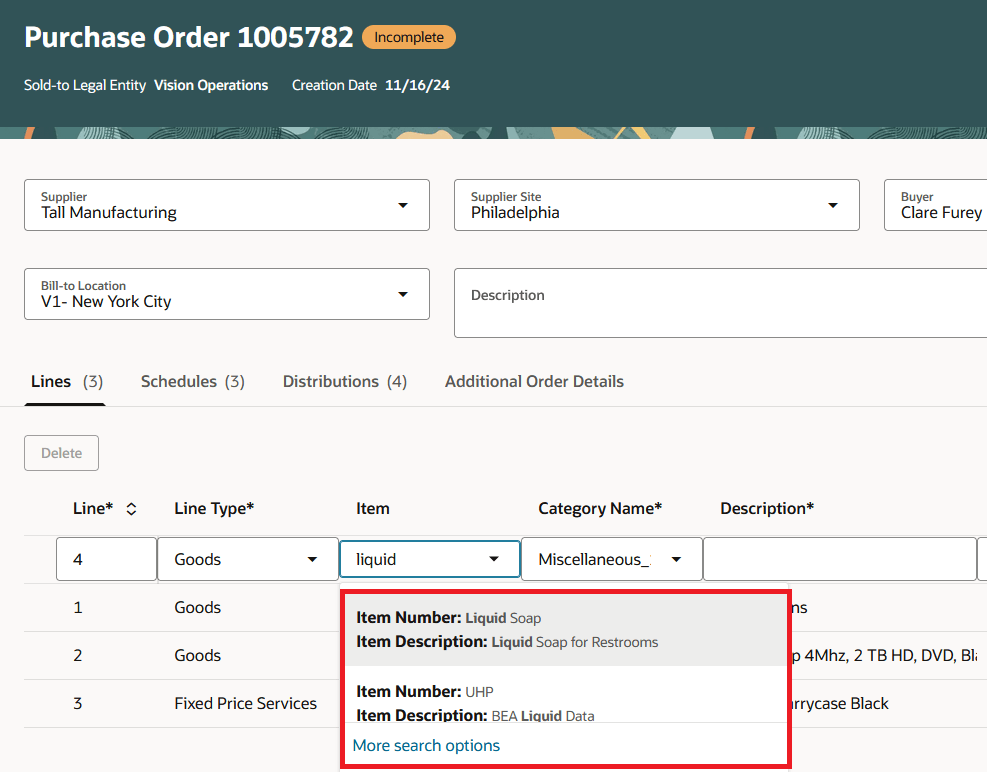
Search for Items on the PO Line Using the New Product Search Experience
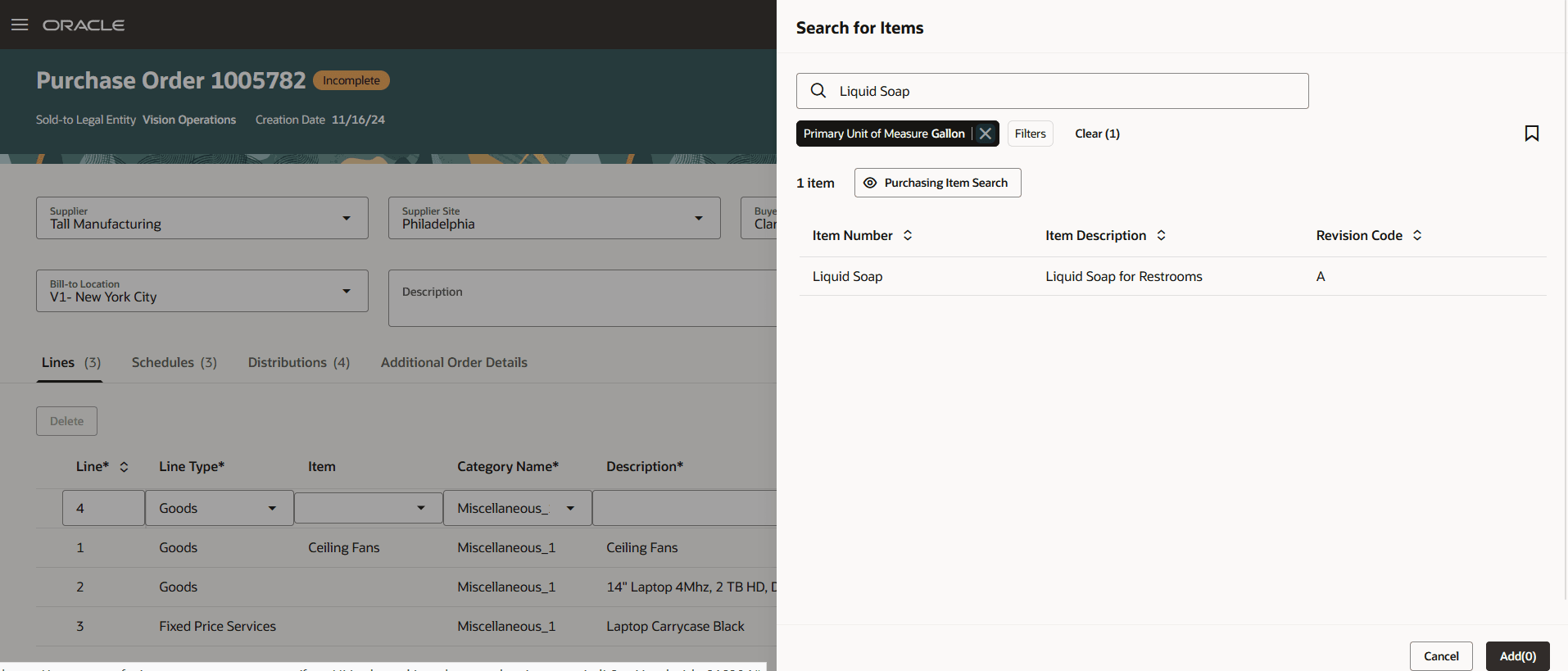
Use the More search options Link to Open a Drawer to Filter Items by the Primary UOM
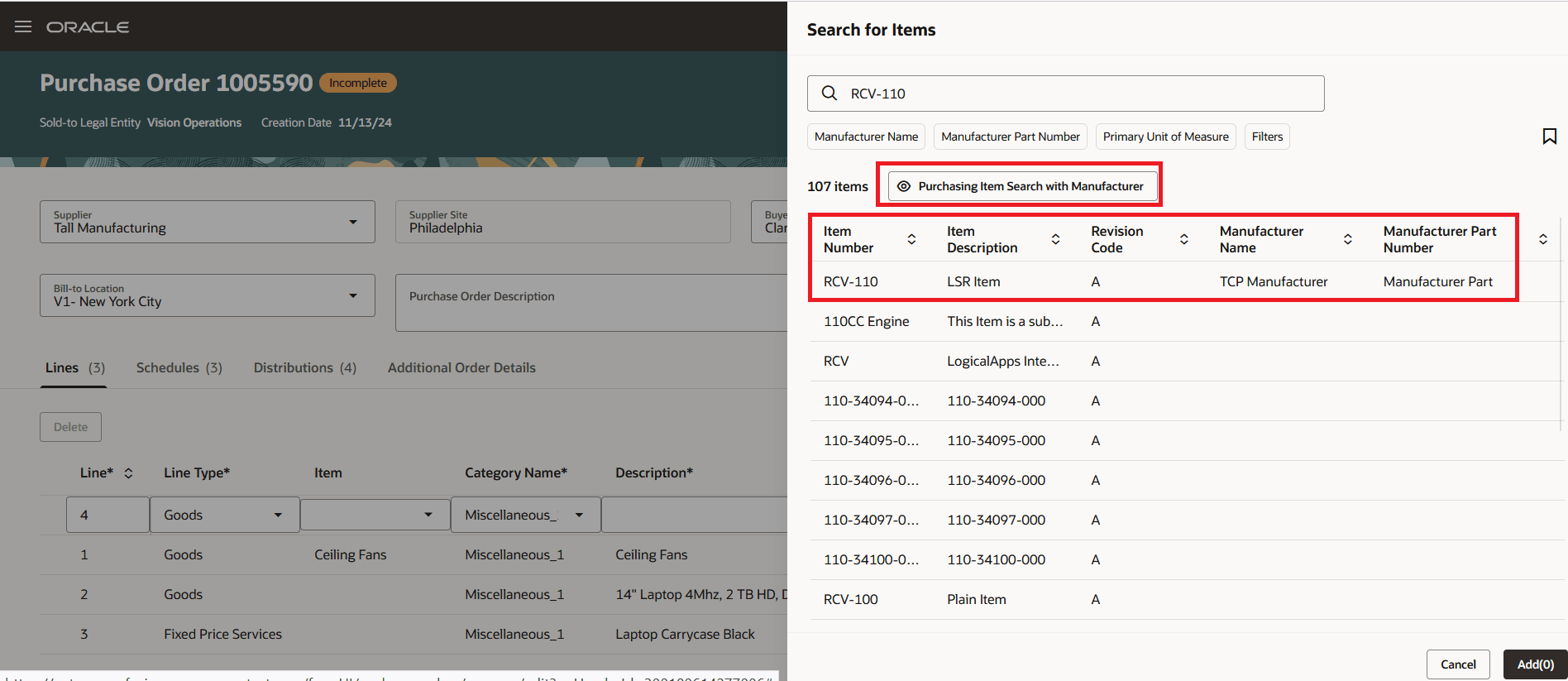
New Search View Configured by Duplicating the Predefined Purchasing Item Search View to Show Manufacturer and Manufacturer Part Number in Search Results
When creating purchase order lines for a predefined item, the application automatically tries to detect an available source agreement based on transaction attributes such as currency, supplier, supplier site, item, ship-to organization, and location. It defaults the agreement on the purchase order line. You can also assign a source agreement by selecting an agreement from the list of values.
Add, Edit or Delete Lines
When you navigate to the Edit Purchase Order page, you see an empty row in the Lines tab with attribute values defaulted. You can add a purchase order line by updating key information on this row, such as line type, category, price, quantity, and unit of measure, and clicking the row-level check mark icon.

Empty Default Row in the Purchase Order Lines Tab with the Row-Level Check Mark and Cross Icons

Add a PO Line by Updating Key Attributes on the Default Row and Using the Row-Level Checkmark
When you apply changes on a newly added purchase order line:
- The line is added to the purchase order, and a schedule and distribution are automatically created for that line if sufficient valid information is available.
- The application also inserts a new line row on the top of the table to facilitate data entry.
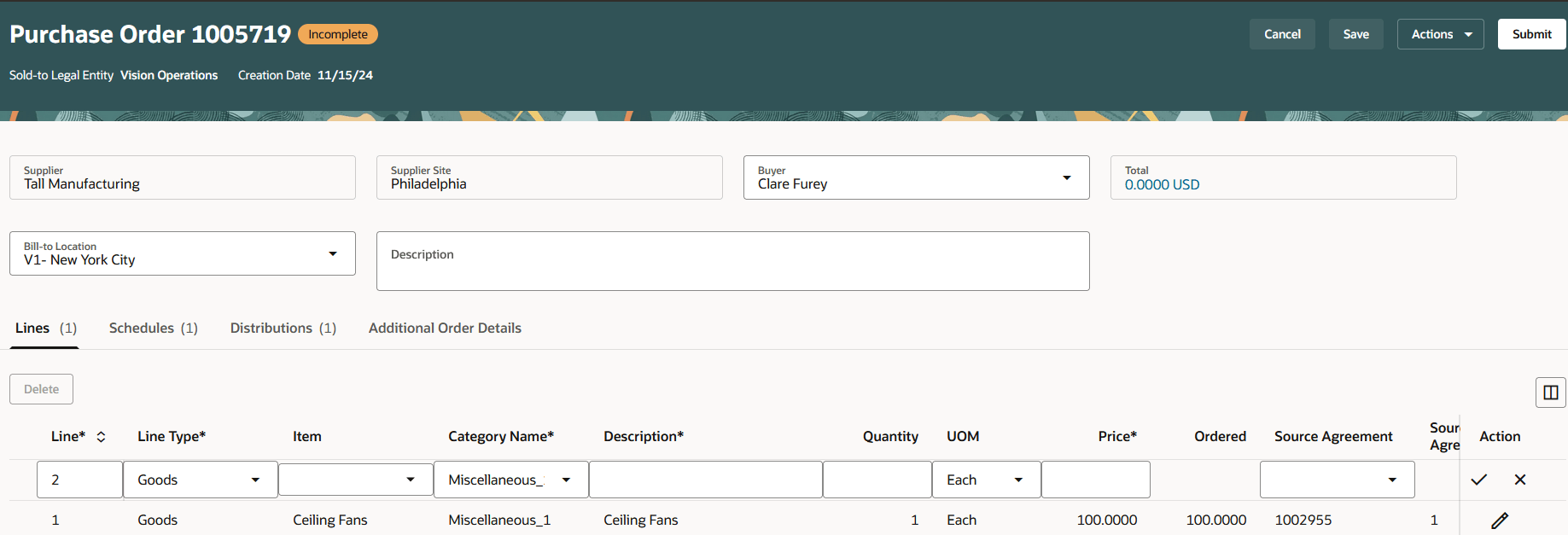
PO With 1 Line and an Empty Line Row
After adding lines to your purchase order, you can save the order to view the order total.
You can use the row-level edit option to edit a purchase order line.
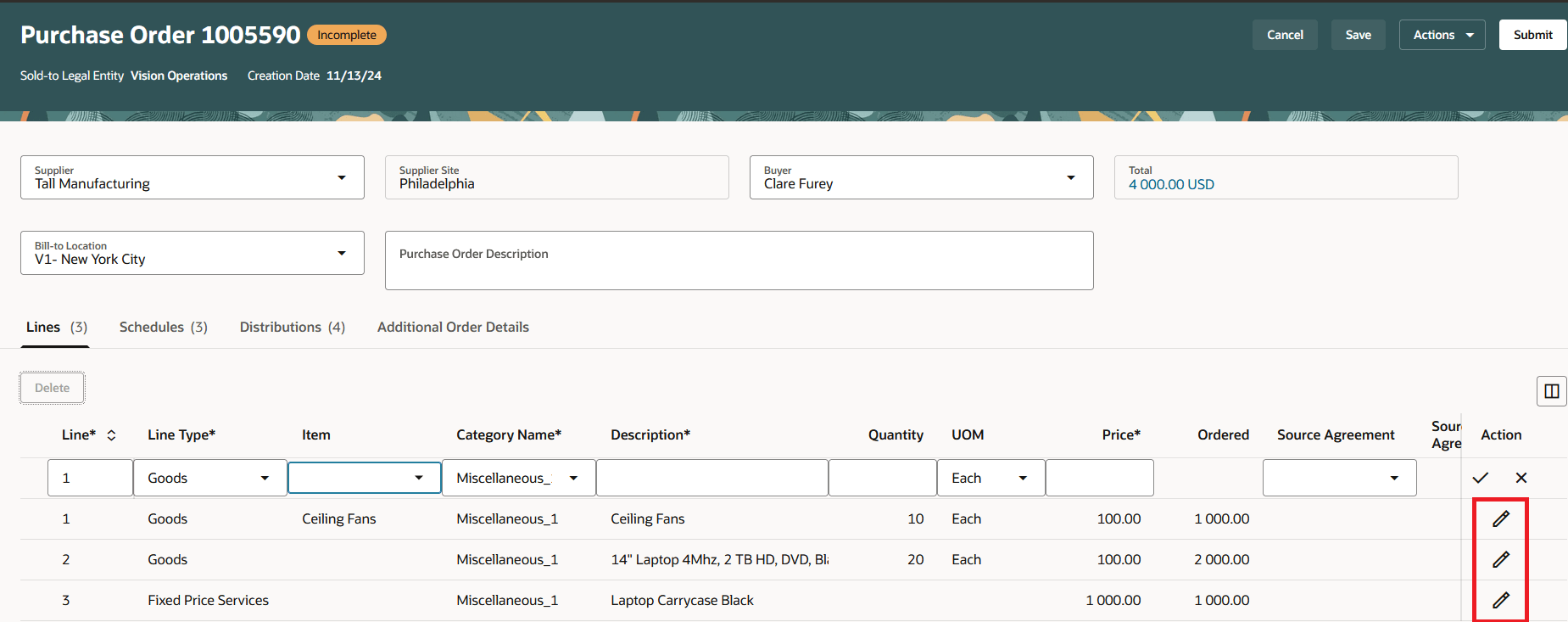
Edit PO Line Using the Row-level Edit Option
You can dismiss the changes you entered on a line by clicking the row-level cross icon.
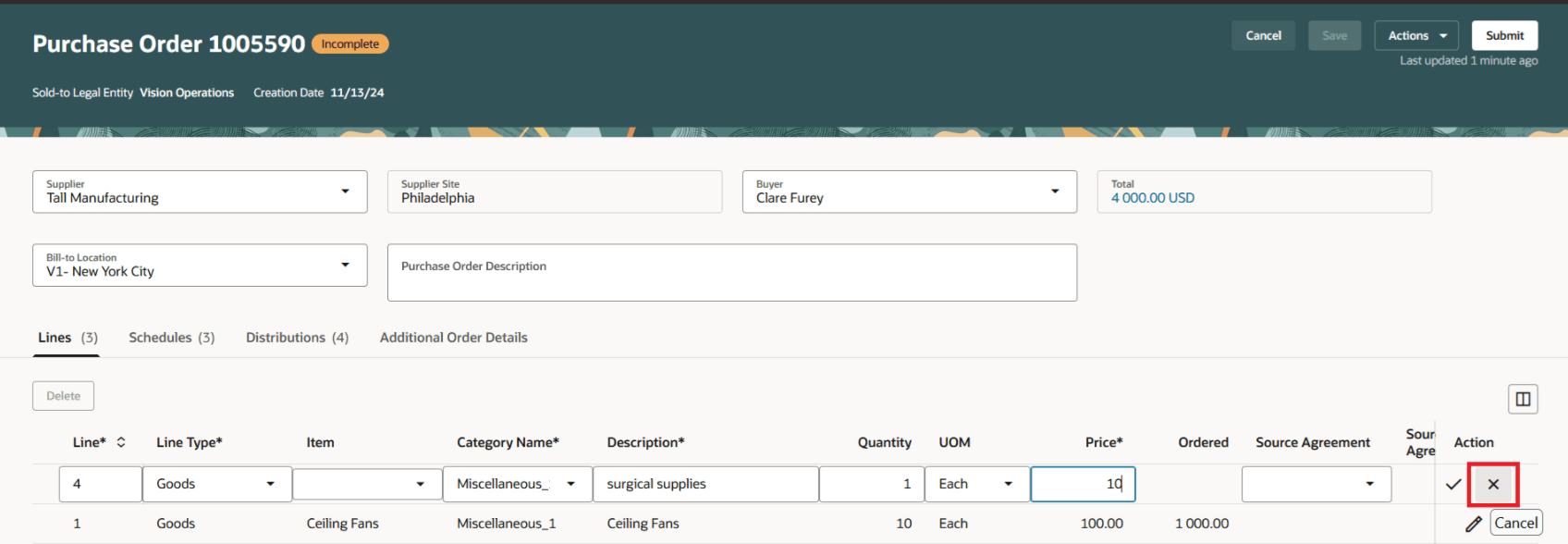
Use the Row-Level Cross Icon to Dismiss Changes Entered on a PO line
Use the Delete button on the Lines tab to delete a purchase order line that you previously saved.
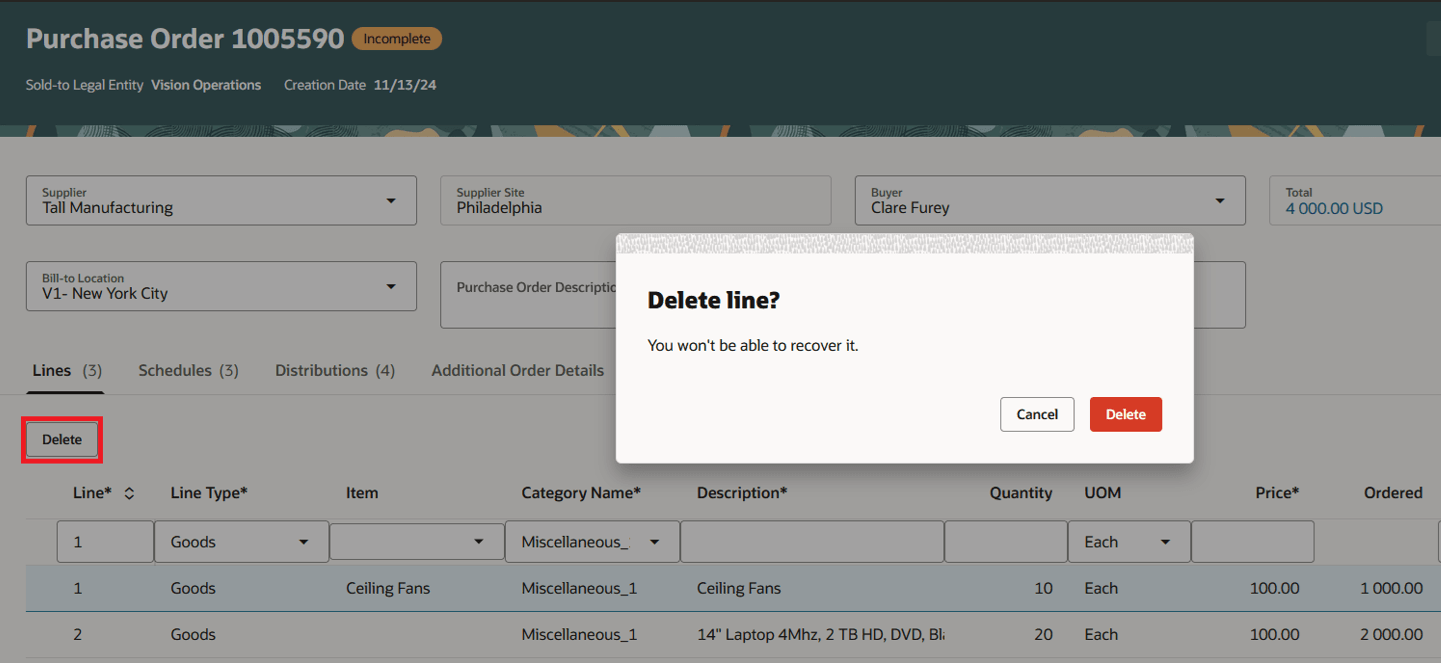
Use the Delete Button to Delete a PO Line
Purchase Order Schedules
Use the Schedules tab to enter key delivery attributes such as ship-to location, shipping method, quantity, date you want the supplier to deliver the items, and country of origin.
You can create multiple purchase order schedules by splitting an existing schedule to stagger the deliveries, update attributes on a schedule, or delete a schedule that you previously saved.
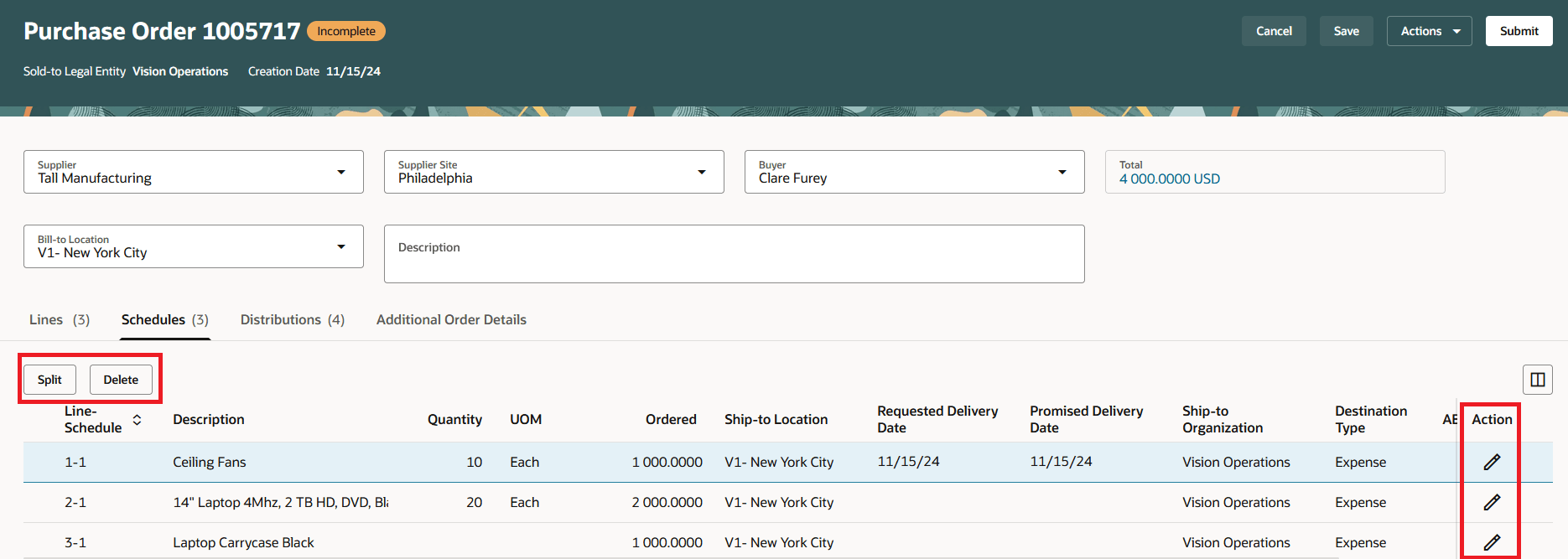
Split, Delete, and Row-Level Edit Options on the PO Schedule
Purchase Order Distributions
Use the Distributions tab to enter key information such as PO charge account, deliver-to location, and requester.
You can create multiple distributions by splitting an existing distribution to allocate costs, update attributes on distributions, or delete a distribution that you previously saved.
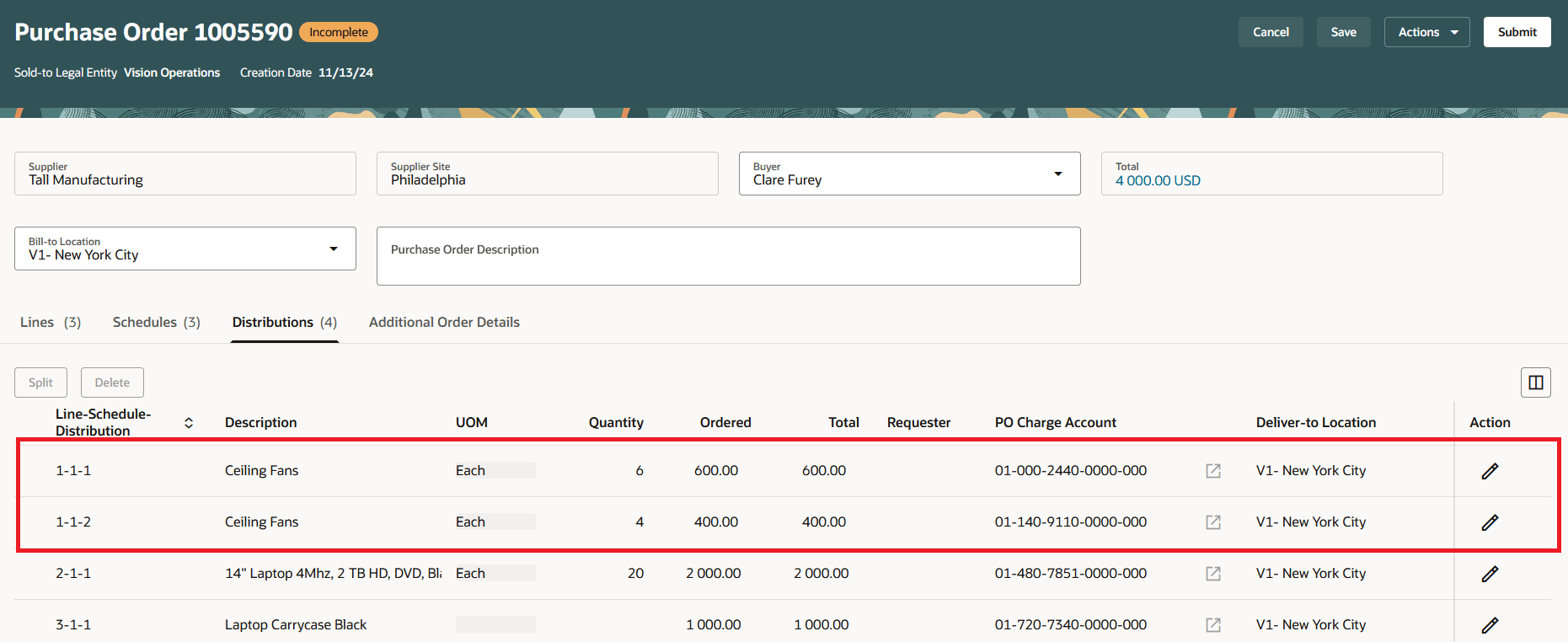
Multiple PO Distributions Created by Splitting an Existing Distribution to Allocate Costs to Multiple PO Charge Accounts
More Details
Use the More details drawer on the lines, schedules, and distributions tab to enter additional information specific to your purchase order and enter notes and attachments. The notes you add are visible to the suppliers and receivers as part of the procurement process. When adding attachments you can indicate whether the attachment is for an approver, receiver, buyer, supplier, or internal use only.
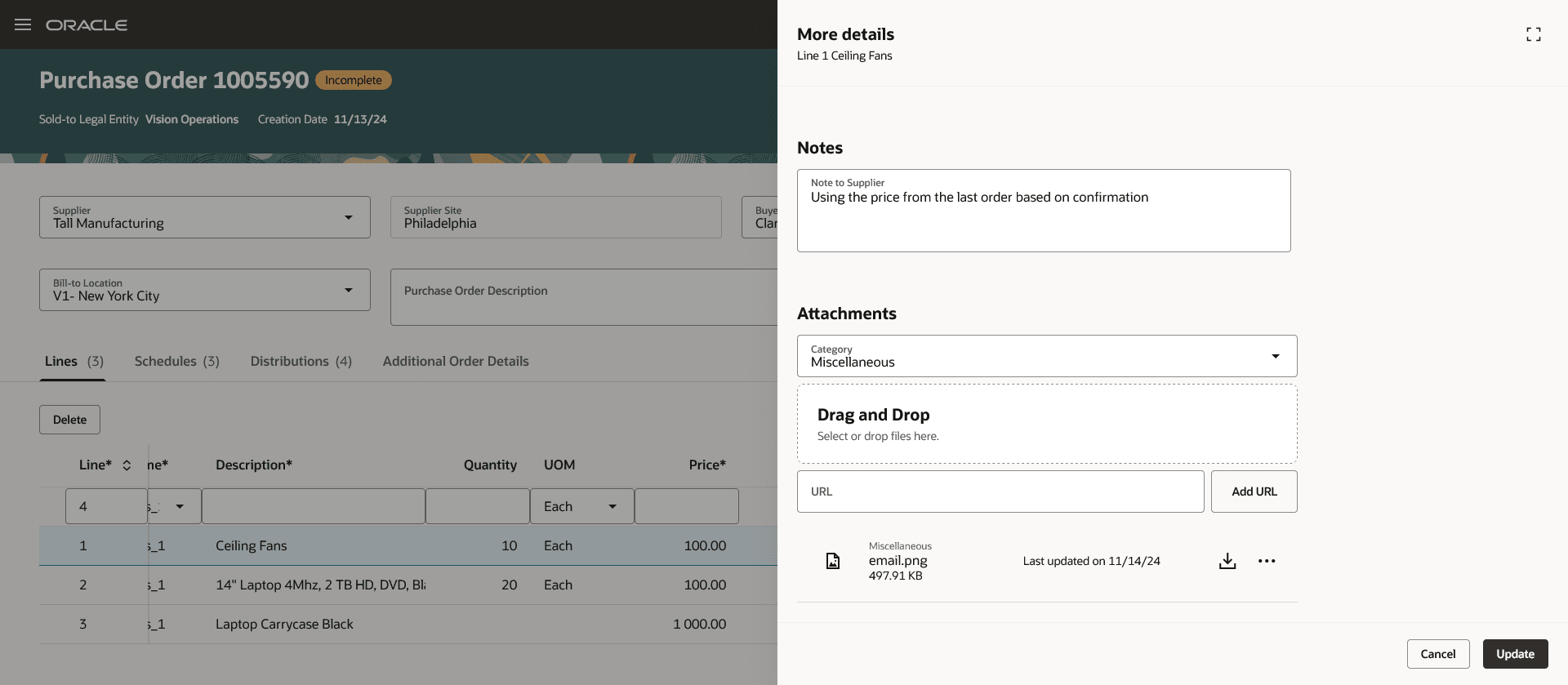
More details Drawer on the PO Line

More details Drawer on the PO Schedule
Additional Order Details
Use the Additional Order Details tab to specify the overriding approver, communication method, communication email, cc, bcc recipients, additional supplier contact email address and conversion rates on the purchase order header.
You can also enter additional information on the PO header using descriptive flexfields, notes, and attachments from this tab.
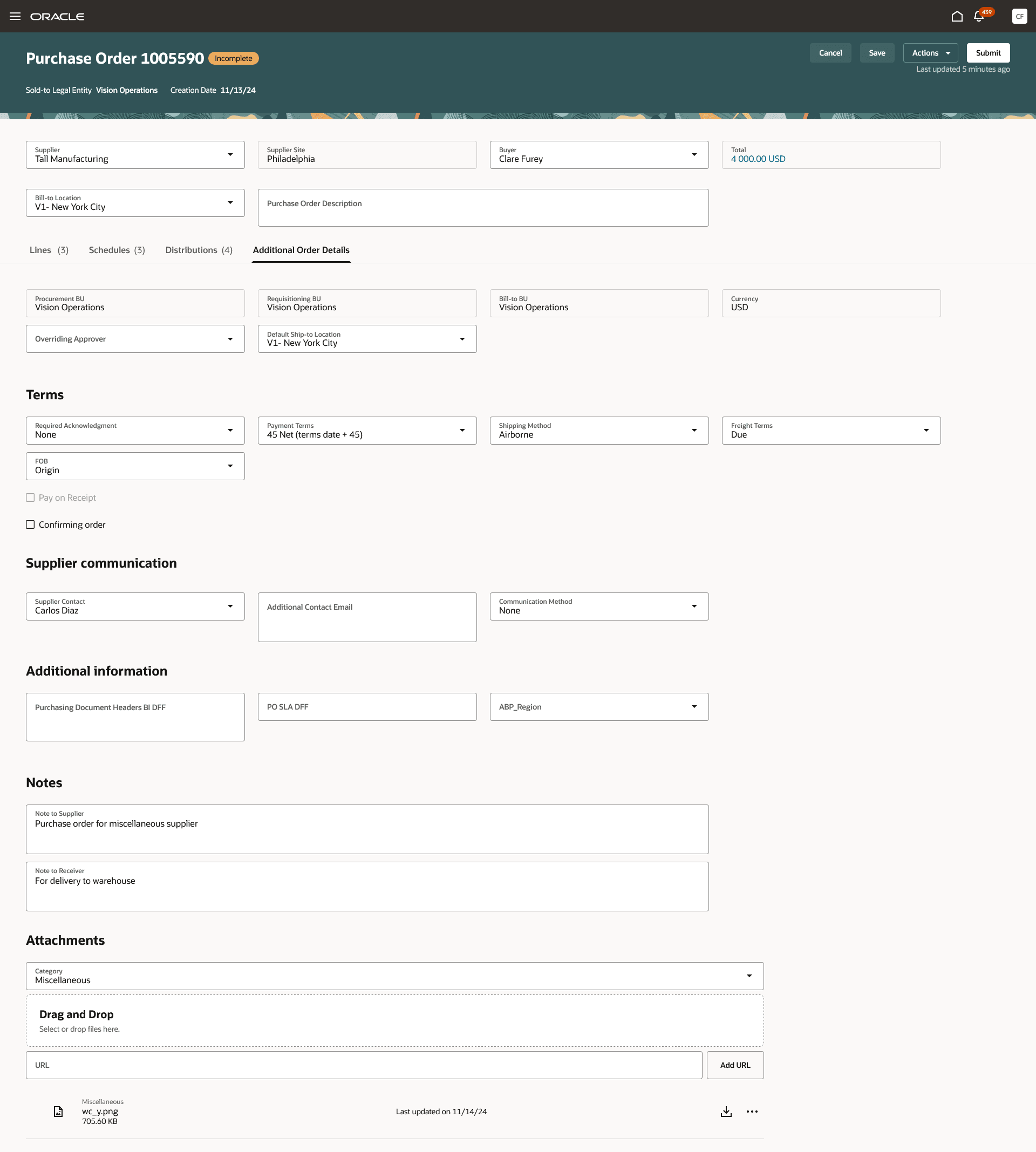
Additional Order Details
Total Amount Drawer
You can see the total amount breakdown after saving a purchase order.
Click on the total amount in the purchase order header to open a drawer that displays the breakdown of the total amount.
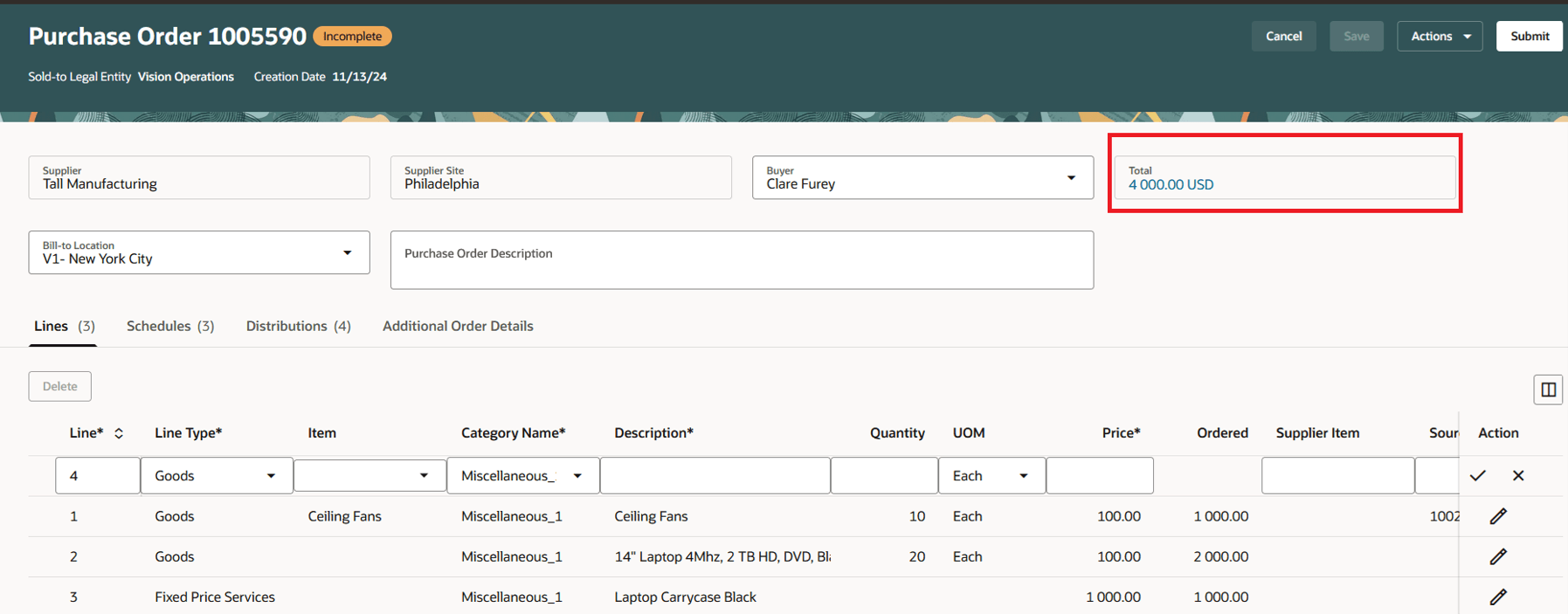
Total Amount on the PO Header

PO Total Amount Drawer
Column Selector
Use the column selector to configure the columns displayed in the Lines, Schedules, and Distributions tabs. You can hide columns that you don't need and select additional columns based on your interest.
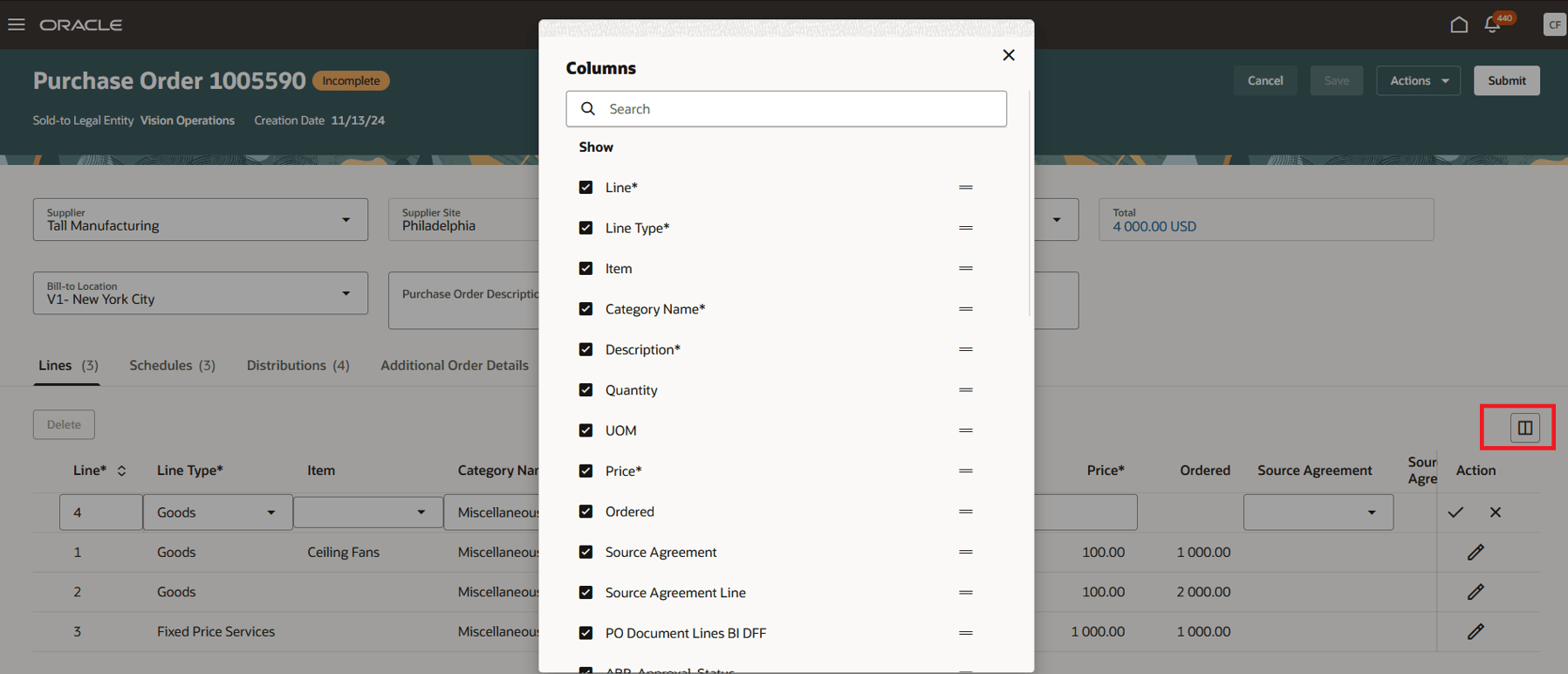
Column Selector on the PO Line
Most Recently Used Search
The list of value fields, such as supplier, supplier site, and deliver-to location, uses the most recently used (MRU) search feature. You can select from 5 most recently used values in the list of value fields without explicitly searching for those values. The most recently used values are displayed first, followed by other valid values. You can also search for other valid values by typing inside the field. The recently used values are displayed based on the search criteria.
Purchase Order Actions
You can initiate these actions on the purchase order:
- Delete
- Validate
- View PDF
- Save
- Save and Close
- Submit
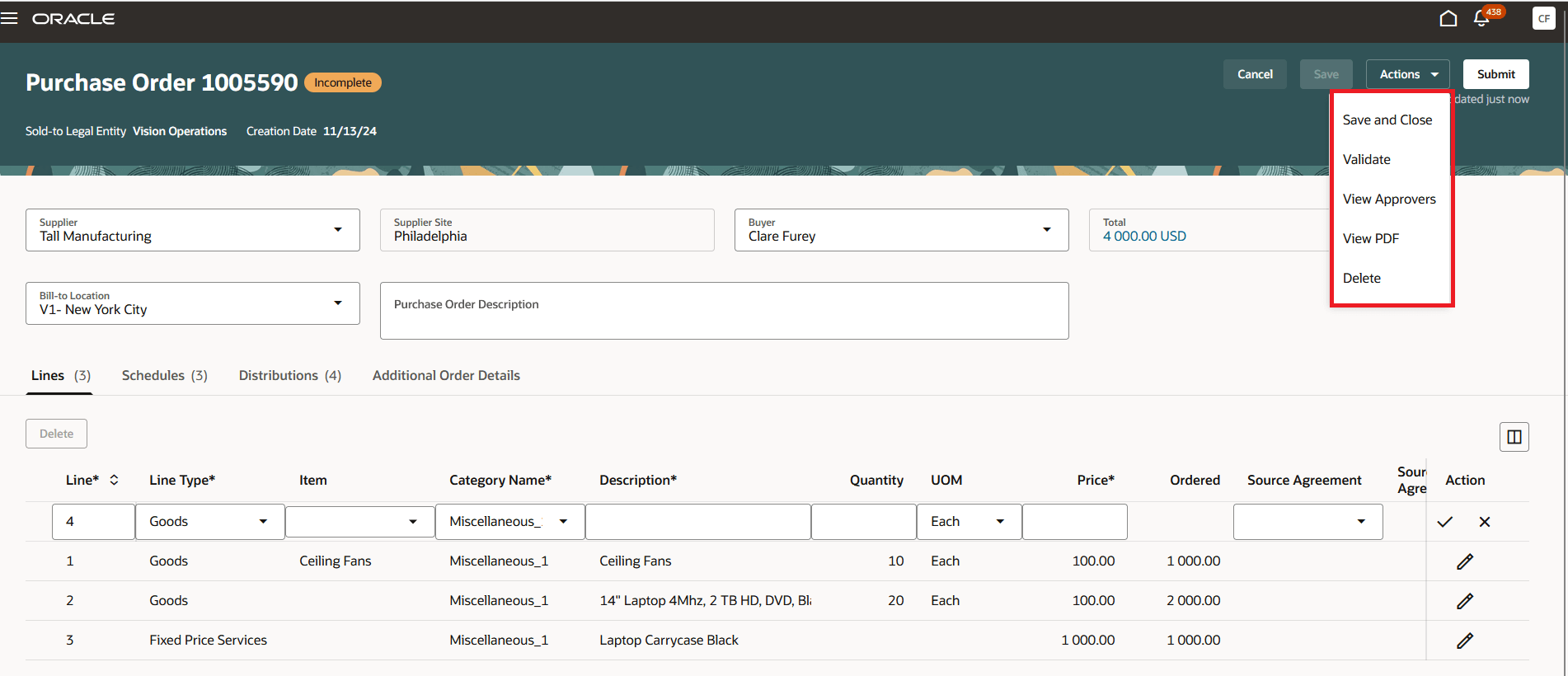
Purchase Order Actions
Use the View Approvers actions to preview the list of approvers required to review the purchase order as part of the approval process.
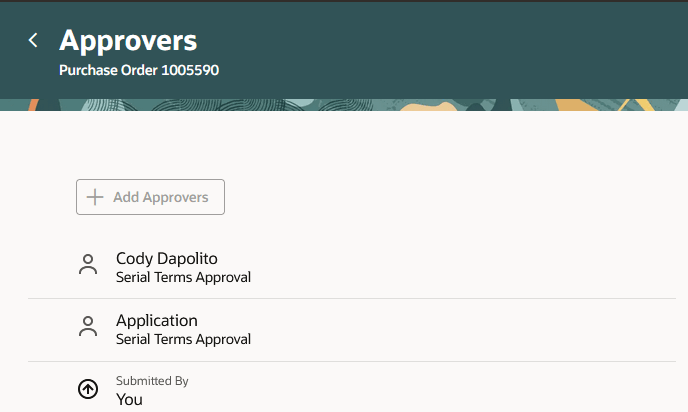
Preview List of Approvers for the PO
You can also add more approvers to the default list presented. To add an ad hoc approver, select an approver from the desired rule participant and use the Add Approvers option. You can search for approvers using the first name, last name, or email.

Add Ad Hoc Approver on the PO Using the Add Approvers Button
Steps to Enable
You need to enable the Redwood Page for Purchase Orders Enabled for Purchasing (ORA_PO_PURCHASE_ORDERS_REDWOOD_ENABLED) profile option to access the new Purchase Orders page from which you can create purchase orders. By default, this profile option is disabled.
To enable the profile option, follow these steps:
- In the Setup and Maintenance work area, search and select the Manage Administrator Profile Values task.
- On the Manage Administrator Profile Values page, search for and select the profile option name or code.
- Set the Profile Value to Y.
- Click Save and Close. Changes in the profile value will affect users the next time they sign in.
To search and select predefined items on a purchase order line, configure item search using the new user search experience by following these steps.
- Opt in to the Search Items Using the New User Interface feature under the Product Management offering.
- Enable the ORA_FND_SEARCH_INITIAL_INGEST_JOB_SCHEDULE_ENABLED profile option.
- Configure the item index and view. Before using item search, you must make sure the index and views are configured. You must build the index at startup. All indexes are managed through the Configure Index task and all views are managed through the Configure View task. For an overview of product management search, refer to the Overview of Product Management Search topic.
- Configure data security for item classes for each pairing of roles to organizations or users to organizations. The root item class data security configuration is only required when Oracle Product Hub is licensed. To know how to set up data security for item classes, refer to the Set Up Data Security for Item Classes topic.
Tips And Considerations
- Context-sensitive descriptive flexfields are displayed in the More Details drawer, while global descriptive flexfields are displayed both on the lines, schedules, and distributions table and the More details drawer.
- Save the purchase order to view the updated purchase order total.
- Save the purchase order to update the supplier and supplier site after removing the source agreement from the purchase order lines.
- Supplier and Supplier Site attributes are mandatory, and you must provide these details in the New purchase order drawer.
- To select a sold-to legal entity on the purchase order, use the Override Purchase Order Sold To Legal Entity privilege. To select a bill-to business unit on the purchase order, use the Override Purchase Order Bill To Business Unit privilege. These privileges aren't assigned to any predefined job role.
- The application ignores the default empty line row when you submit a purchase order.
- You can configure guided journeys for the new Edit Purchase Order page and provide users with guidance such as tutorials, company policies, and best practices.
- You can use Visual Builder Studio to hide or show fields on the purchase order header, additional order information, and more details drawer using business rules.
- Features not supported in this release:
- Change Orders
- Project descriptive flexfields
- Budgetary control validations
- Inventory, drop ship, and work order destination types
- Dual units of measure
- Tax determinant attributes
- Buyer management transportation
- Supplier discounts
- Contract terms
- Master contract
- Price derivation based on agreement line start date
- Complex work purchase orders
- Credit lines
- Financial orchestration flow
- Special handling purchase orders
- Procurement checklists
- U.S. Federal attributes
Key Resources
- For an overview of product management search, refer to the Overview of Product Management Search topic.
- To know how to set up data security for item classes, refer to the Set Up Data Security for Item Classes topic.
- For information about using Oracle Visual Builder Studio to extend your Redwood application pages, see Oracle Fusion Cloud HCM and SCM: Extending Redwood Applications for HCM and SCM Using Visual Builder Studio
Access Requirements
Users who are assigned a configured job role that contains this new privilege can access this feature:
- Manage Purchase Orders Using a Redwood Page (PO_MANAGE_PO_WITH_REDWOOD_PRIV)
Users who are assigned a configured job role that contains this new duty role can access this feature:
- Purchasing List of Values and Attribute Defaulting REST (ORA_PO_LOV_DEFAULTING_REST_DUTY)
You will also need these existing privileges to access this feature:
- View Purchase Order Work Area (PO_VIEW_PURCHASING_WORKAREA_PRIV)
- Create Purchase Order (PO_CREATE_PURCHASE_ORDER_PRIV)
- View Supplier List of Values Using REST Service (POZ_VIEW_SUPPLIER_LOV_REST_SERVICE_PRIV)
- View Product Management Search (EGP_VIEW_PRODUCT_MGT_SEARCH_PRIV)
- Get Search View REST (EGP_GET_SEARCH_VIEW_REST_PRIV)
- GET Product Management Index REST (EGP_GET_PM_INDEX_REST_PRIV)